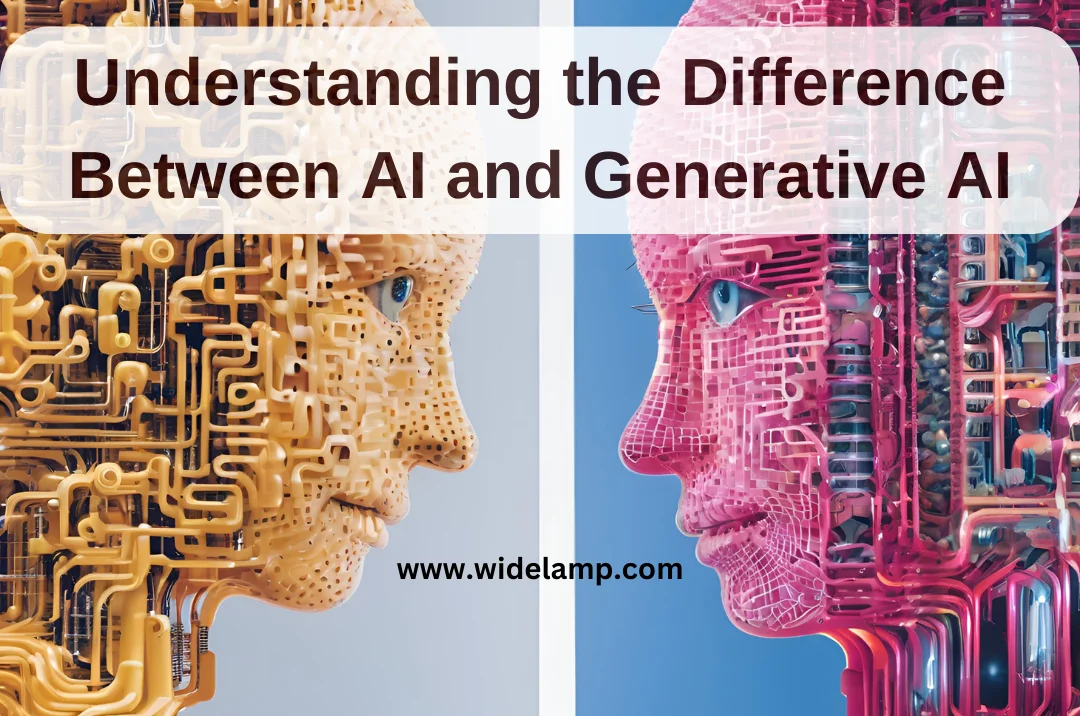|
Getting your Trinity Audio player ready... |
Difference Between AI and Generative AI
Understanding the Difference Between AI and Generative AI, In the rapidly evolving world of technology, Artificial Intelligence (AI) has become a buzzword that touches nearly every industry. However, as AI continues to develop, a specific branch known as Generative AI is gaining significant attention. While both AI and Generative AI are transformative, they serve different purposes and have distinct features, capabilities, and implications for the future. In this article, we will delve into the differences between AI and Generative AI, explore their unique features, and predict which might have a more profound impact on the future.
What is Artificial Intelligence (AI)?
Artificial Intelligence (AI) refers to the broad concept of machines being able to carry out tasks that would normally require human intelligence. These tasks include learning, reasoning, problem-solving, perception, and even decision-making. AI can be categorized into three types:
- Narrow AI (Weak AI): This is the most common form of AI that we encounter today. Narrow AI is designed to perform a specific task, such as voice recognition, image classification, or language translation. Examples include Siri, Alexa, and recommendation algorithms on platforms like Netflix and Amazon.
- General AI (Strong AI): General AI is a theoretical form of AI that can perform any intellectual task that a human can do. It would have the ability to understand, learn, and apply knowledge in various contexts, just like a human. However, as of now, General AI remains largely in the realm of science fiction.
- Superintelligent AI: This is a level of AI that surpasses human intelligence across all domains. While still speculative, superintelligent AI could potentially outperform humans in every intellectual endeavor, from scientific research to social interactions.
What is Generative AI?
Generative AI is a subset of artificial intelligence that focuses on creating new content rather than analyzing existing data. Generative AI models are designed to generate data that is similar to the input data they were trained on. This technology leverages advanced machine learning techniques, particularly deep learning and neural networks, to produce outputs that are indistinguishable from human-created content.
Some of the most common applications of Generative AI include:
- Text Generation: Tools like GPT (Generative Pre-trained Transformer) models, including GPT-4, are capable of generating human-like text based on a given prompt.
- Image Generation: Generative Adversarial Networks (GANs) can create realistic images, such as faces that don’t exist in reality.
- Music and Art Creation: Generative AI can compose music or create digital artwork that mimics the style of human artists.
- Synthetic Data Generation: Generative AI can produce synthetic data for training machine learning models, which is especially useful when real data is scarce or privacy concerns exist.
Key Differences Between AI and Generative AI
- Purpose and Functionality:
- AI: AI is primarily focused on analyzing, processing, and making decisions based on existing data. It excels at tasks like prediction, classification, and optimization.
- Generative AI: Generative AI, on the other hand, is centered around creation. It generates new content or data that resembles the input data, whether that’s text, images, music, or other forms of media.
- Underlying Technology:
- AI: AI often relies on machine learning algorithms that learn from large datasets to make predictions or decisions. Techniques such as supervised learning, unsupervised learning, and reinforcement learning are commonly used.
- Generative AI: Generative AI uses specific models like GANs (Generative Adversarial Networks) or transformers that are trained to create new data. These models often involve a generator that creates new data and a discriminator that evaluates it for authenticity.
- Applications:
- AI: Applications of AI are vast and include autonomous vehicles, healthcare diagnostics, financial forecasting, customer service chatbots, and more.
- Generative AI: Generative AI is more niche, with applications in creative industries like art, music, literature, and game development. It’s also used in areas like synthetic data generation and drug discovery.
- Complexity and Resource Requirements:
- AI: AI systems can range from simple algorithms to complex systems requiring significant computational power, especially in cases like deep learning.
- Generative AI: Generative AI models are typically resource-intensive, requiring vast amounts of data and computational power, especially for training purposes. The complexity of generating realistic and coherent outputs also adds to the resource demands.
- Human Involvement:
- AI: In many AI applications, human oversight is necessary to ensure accuracy, and ethical considerations, and to provide contextual understanding that AI may lack.
- Generative AI: While Generative AI can create content autonomously, human intervention is often needed to guide the process, refine outputs, and ensure that the generated content meets the desired criteria.
Comparing Features of AI and Generative AI
- Learning and Adaptability:
- AI: Traditional AI is adept at learning from data and improving over time. It can adapt to new inputs and refine its decision-making processes based on feedback.
- Generative AI: Generative AI also learns from data but is more focused on understanding patterns to create new content. Its adaptability lies in its ability to generate increasingly sophisticated outputs with more training.
- Creativity:
- AI: AI is generally seen as analytical rather than creative. It excels at tasks that require logic, pattern recognition, and decision-making based on set rules.
- Generative AI: Generative AI is inherently creative, producing new and unique content that can often surprise even its creators. It pushes the boundaries of what AI can do by entering the realm of human creativity.
- Precision and Reliability:
- AI: AI systems are designed for precision and reliability, especially in critical applications like healthcare and finance. They aim to reduce errors and provide consistent results.
- Generative AI: Generative AI, while capable of producing impressive outputs, may not always be precise. The outputs can vary widely in quality, and there is often a need for human curation.
- Ethical and Social Implications:
- AI: AI’s ethical concerns often revolve around privacy, data security, bias, and the potential for job displacement.
- Generative AI: Generative AI raises additional ethical issues, particularly around intellectual property, the potential for deepfakes, and the authenticity of content.
Future Predictions: AI vs. Generative AI
Predicting the future of AI and Generative AI involves considering their current trajectories and potential impact on society.
- AI’s Future:
- Continued Integration: AI will continue to be integrated into more aspects of daily life, from smart homes to autonomous vehicles. The focus will be on making AI more reliable, ethical, and user-friendly.
- Advancements in General AI: While still theoretical, advancements in General AI could lead to machines that can perform any cognitive task that a human can, fundamentally transforming industries and even society.
- Generative AI’s Future:
- Creative Industries Revolution: Generative AI is poised to revolutionize creative industries by democratizing content creation. Artists, writers, and musicians will increasingly collaborate with AI to push creative boundaries.
- Ethical Challenges: As Generative AI becomes more sophisticated, the challenges around authenticity, intellectual property, and misuse (such as deepfakes) will intensify, requiring new legal and ethical frameworks.
- Who is Better for the Future: AI or Generative AI?
- AI’s Versatility: AI’s broad applicability across industries makes it a critical technology for the future. Its ability to automate, optimize, and enhance decision-making processes ensures its continued relevance and growth.
- Generative AI’s Creative Potential: Generative AI’s strength lies in its creative potential, which could redefine entire industries. However, its niche application means it will likely complement rather than replace traditional AI.
In conclusion, both AI and Generative AI have their unique strengths and will play significant roles in shaping the future. AI, with its broad applications and focus on analysis and decision-making, is likely to continue as a cornerstone technology across various sectors. Generative AI, with its creative capabilities, will transform creative industries and provide new ways of generating content and ideas. Ultimately, the future will likely see a convergence of these technologies, where AI and Generative AI work together to create smarter, more creative, and more efficient systems.

Q & A – Section
Questions which are very helpful for everyone and clear some doubt…
What is Artificial Intelligence (AI)?

AI refers to machines performing tasks requiring human intelligence, such as learning, reasoning, and decision-making. It includes Narrow AI (specific tasks), General AI (human-like cognitive abilities), and Superintelligent AI (surpassing human intelligence).
What is Generative AI?

Generative AI is a subset of AI focused on creating new content like text, images, and music. It uses machine learning techniques, such as GANs and transformers, to generate outputs based on input data.
How do AI and Generative AI differ in purpose?

AI is designed to analyze and process existing data, excelling in prediction and optimization. Generative AI, however, creates new data, focusing on generating content like text or images.
What technologies underpin AI and Generative AI?

AI uses machine learning algorithms, including supervised and unsupervised learning. Generative AI relies on models like GANs and transformers to generate data.
What are some common applications of AI and Generative AI?

AI is used in healthcare diagnostics, autonomous vehicles, and customer service. Generative AI is prevalent in creative industries like art, music, and text generation.
How do AI and Generative AI differ in complexity?

AI systems vary from simple algorithms to complex systems requiring significant computational power. Generative AI is resource-intensive due to the complexity of creating realistic outputs.
How does human involvement differ between AI and Generative AI?

AI often requires human oversight for accuracy and ethics, while Generative AI needs human intervention to refine outputs and meet desired criteria.
Which is more creative: AI or Generative AI?

Generative AI is inherently more creative, producing unique content, whereas AI excels in logic and decision-making.
What are the ethical concerns surrounding AI and Generative AI?

AI raises issues around data privacy, bias, and job displacement, while Generative AI presents challenges related to intellectual property and the misuse of deepfakes.
What does the future hold for AI and Generative AI?

AI will continue to integrate into daily life, advancing towards General AI. Generative AI will revolutionize creative industries but will require frameworks to address ethical challenges.
Form any question suggestion and recommendation please contact on contact@widelamp.com




